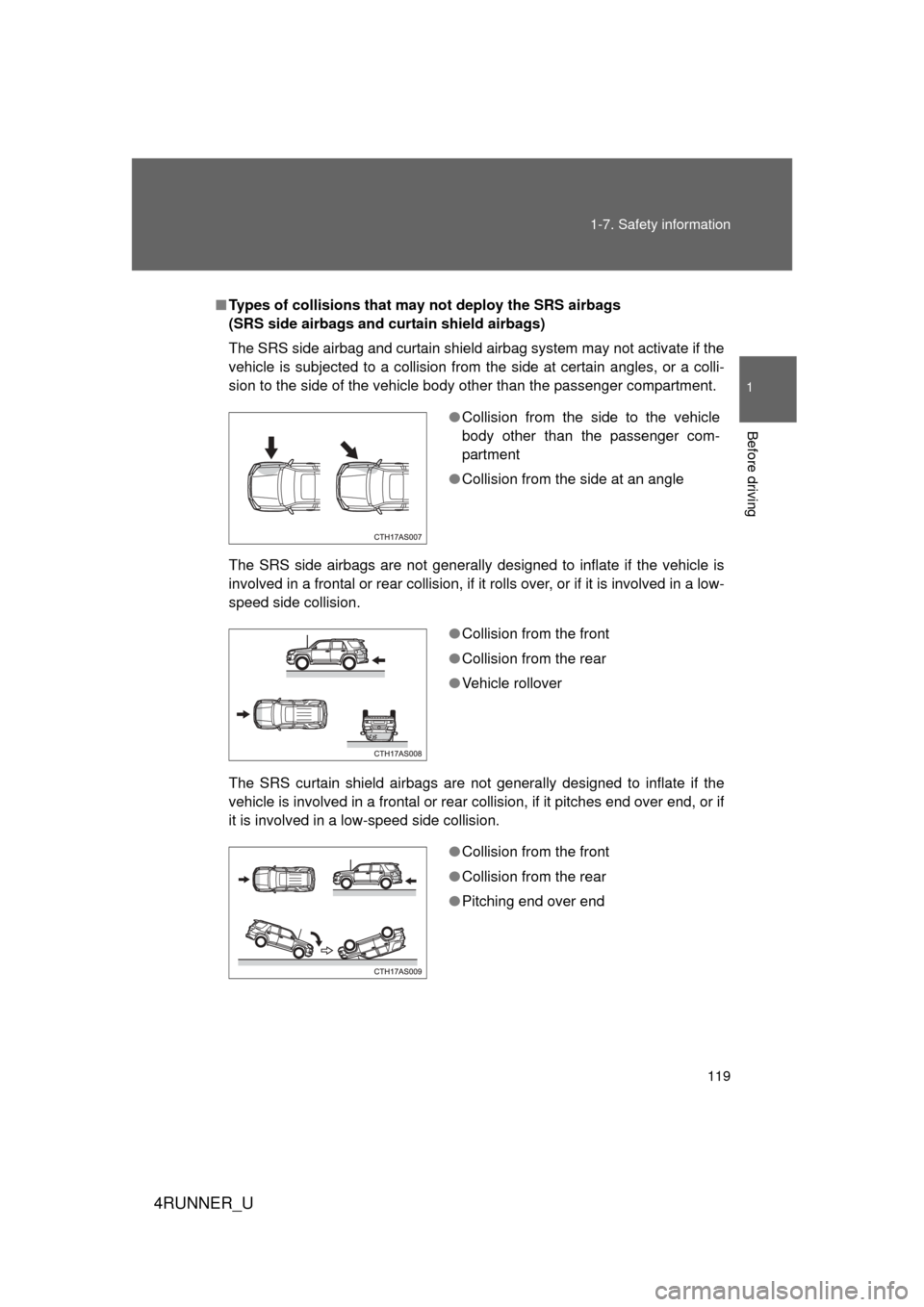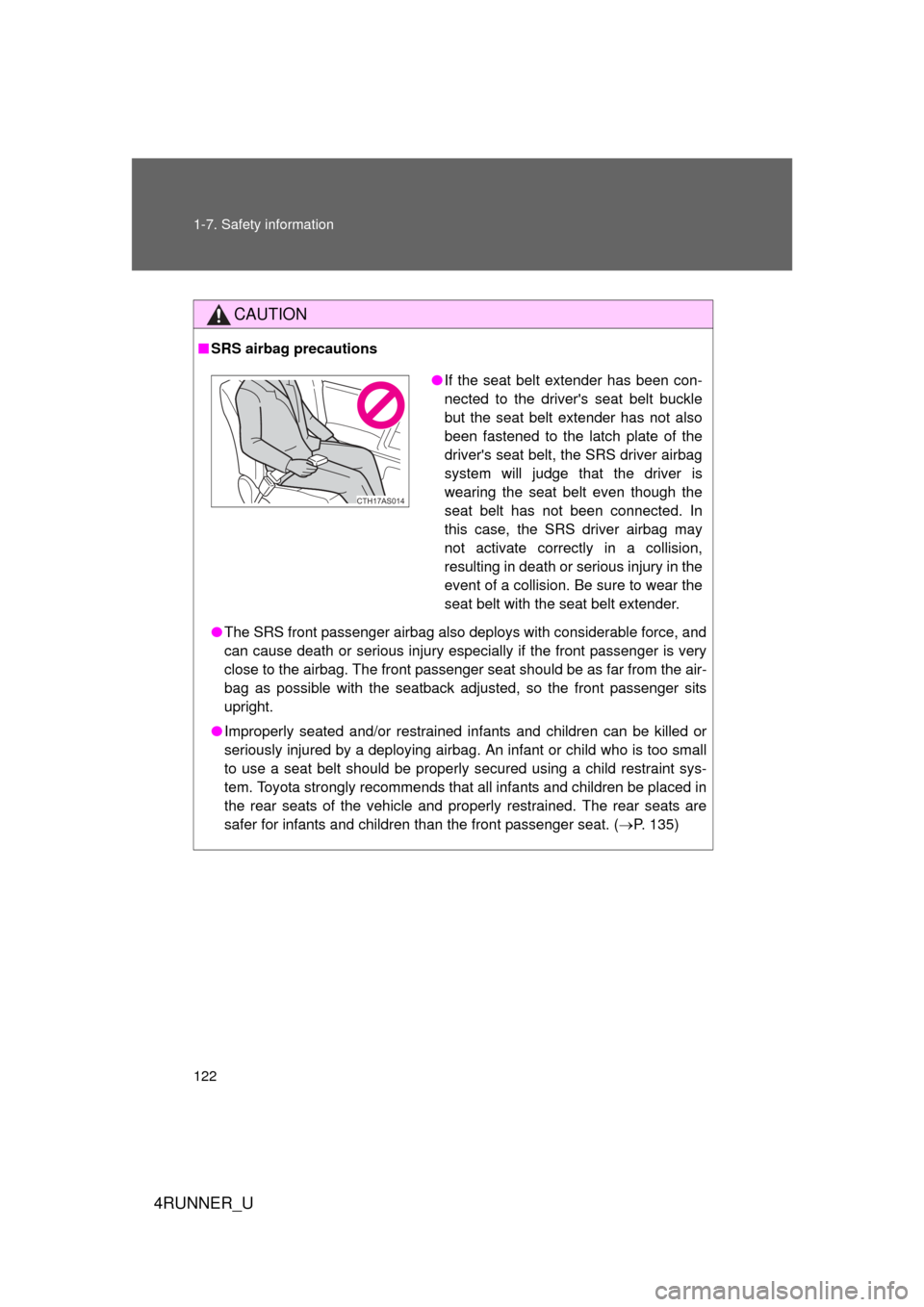Page 117 of 665

117
1-7. Safety information
1
Before driving
4RUNNER_U
■
SRS airbag deployment conditions (SRS front airbags)
● The front SRS airbags will deploy in the event of an impact that exceeds
the set threshold level (the level of force corresponding to an approxi-
mately 12 - 18 mph [20 - 30 km/h] frontal collision with a fixed wall that
does not move or deform).
However, this threshold velocity will be considerably higher if the vehicle
strikes an object, such as a parked vehicle and sign pole, which can move
or deform on impact, or if the vehicle is involved in an underride collision
(e.g. a collision in which the front of the vehicle “underrides”, or goes
under, the bed of a truck etc.).
● It is possible that in some collisions where the forward deceleration of the
vehicle is very close to the designed threshold level, the SRS front air-
bags and the seat belt pretensioners may not activate together.
● The SRS front passenger airbag will not activate if there is no passenger
sitting in the front passenger seat. However, the front passenger airbag
may deploy, if luggage is put in the seat, even if the seat is unoccupied.
■ SRS airbag deployment conditions (SRS side airbags)
The SRS side airbags will deploy in the event of an impact that exceeds the
set threshold level (the level of force corresponding to the impact force pro-
duced by an approximately 3300 lb. [1500 kg] vehicle colliding with the vehi-
cle cabin from a direction perpendicular to the vehicle orientation at an
approximately speed of 12 - 18 mph [20 - 30 km/h]).
■ SRS airbag deployment conditions (SRS curtain shield airbags)
The SRS curtain shield airbags will deploy in the event of vehicle rollover or
an impact that exceeds the set threshold level (the level of force correspond-
ing to the impact force produced by an approximately 3300 lb. [1500 kg]
vehicle colliding with the vehicle cabin from a direction perpendicular \
to the
vehicle orientation at an approximately speed of 12 - 18 mph [20 - 30 km/h]).
Page 118 of 665

118 1-7. Safety information
4RUNNER_U
■Conditions under which the SRS airbags may deploy (inflate), other
than a collision
The SRS front airbags may also deploy if a serious impact occurs to the
underside of your vehicle. Some examples are shown in the illustration.
The SRS curtain shield airbags may also deploy under the situations shown
in the illustration.
■ Types of collisions that may not de ploy the SRS airbags (SRS front air-
bags)
The SRS front airbags are generally not designed to inflate if the vehicle is
involved in a side or rear collision, if it rolls over, or if it is involved in a low-
speed frontal collision. But, whenever a collision of any type causes suffi-
cient forward deceleration of the vehicle, deployment of the SRS front air-
bags may occur.
● Hitting a curb, edge of pavement or
hard surface
● Falling into or jumping over a deep hole
● Landing hard or falling
●The angle of vehicle tip-up is marginal.
● The vehicle skids and hits a curb stone.
●Collision from the side
● Collision from the rear
● Vehicle rollover
Page 119 of 665

119
1-7. Safety information
1
Before driving
4RUNNER_U
■
Types of collisions that may not deploy the SRS airbags
(SRS side airbags and curtain shield airbags)
The SRS side airbag and curtain shield airbag system may not activate if the
vehicle is subjected to a collision from the side at certain angles, or a colli-
sion to the side of the vehicle body other than the passenger compartment.
The SRS side airbags are not generally designed to inflate if the vehicle is
involved in a frontal or rear collision, if it rolls over, or if it is involved in a low-
speed side collision.
The SRS curtain shield airbags are not generally designed to inflate if the
vehicle is involved in a frontal or rear co llision, if it pitches end over end, or if
it is involved in a low-speed side collision.
● Collision from the side to the vehicle
body other than the passenger com-
partment
● Collision from the side at an angle
●Collision from the front
● Collision from the rear
● Vehicle rollover
●Collision from the front
● Collision from the rear
● Pitching end over end
Page 120 of 665

120 1-7. Safety information
4RUNNER_U
■When to contact your Toyota dealer
In the following cases, contact your Toyota dealer as soon as possible. Do
not disconnect the battery cables before contacting your Toyota dealer.
● Any of the SRS airbags have been inflated.
●The front of the vehicle is damaged or
deformed, or was involved in an acci-
dent that was not severe enough to
cause the SRS airbags to inflate.
● A portion of a door is damaged or
deformed, or the vehicle was involved
in an accident that was not severe
enough to cause the SRS side airbags
and curtain shield airbags to inflate.
● The pad section of the steering wheel,
dashboard near the front passenger air-
bag or lower portion of the instrument
panel is scratched, cracked, or other-
wise damaged.
● The surface of the seats with the side
airbag is scratched, cracked, or other-
wise damaged.
● The portion of the front and rear pillar
garnish, or roof interior containing the
curtain shield airbags inside is
scratched, cracked or otherwise dam-
aged.
CTH17AS078
Page 121 of 665

121
1-7. Safety information
1
Before driving
4RUNNER_U
CAUTION
■
SRS airbag precautions
Observe the following precautions regarding the SRS airbags.
Failure to do so may cause death or serious injury.
● The driver and all passengers in the vehicle must wear their seat belts
properly.
The SRS airbags are supplemental devices to be used with the seat belts.
● The SRS driver airbag deploys with considerable force, and can cause
death or serious injury especially if the driver is very close to the airbag.
The National Highway Traffic Safety Administration (NHTSA) advises:
Since the risk zone for the driver’s airbag is the first 2 - 3 in. (50 - 75 mm)
of inflation, placing yourself 10 in. (250 mm) from your driver airbag pro-
vides you with a clear margin of safety. This distance is measured from the
center of the steering wheel to your breastbone. If you sit less than 10 in.
(250 mm) away now, you can change your driving position in several
ways:
• Move your seat to the rear as far as you can while still reaching the pedals comfortably.
• Slightly recline the back of the seat. Although vehicle designs vary, many drivers can achieve the 10 in.
(250 mm) distance, even with the driver seat all the way forward, sim-
ply by reclining the back of the seat somewhat. If reclining the back of
your seat makes it hard to see the road, raise yourself by using a firm,
non-slippery cushion, or raise the seat if your vehicle has that feature\
.
• If your steering wheel is adjustable, tilt it downward. This points the air- bag toward your chest instead of your head and neck.
The seat should be adjusted as recommended by NHTSA above, while
still maintaining control of the foot pedals, steering wheel, and your view of
the instrument panel controls.
Page 122 of 665

122 1-7. Safety information
4RUNNER_U
CAUTION
■SRS airbag precautions
● The SRS front passenger airbag also deploys with considerable force, and
can cause death or serious injury especially if the front passenger is very
close to the airbag. The front passenger seat should be as far from the air-
bag as possible with the seatback adjusted, so the front passenger sits
upright.
● Improperly seated and/or restrained in fants and children can be killed or
seriously injured by a deploying airbag. An infant or child who is too small
to use a seat belt should be properly secured using a child restraint sys-
tem. Toyota strongly recommends that all infants and children be placed in
the rear seats of the vehicle and properly restrained. The rear seats are
safer for infants and children than the front passenger seat. ( P. 135)
●If the seat belt extender has been con-
nected to the driver's seat belt buckle
but the seat belt extender has not also
been fastened to the latch plate of the
driver's seat belt, the SRS driver airbag
system will judge that the driver is
wearing the seat belt even though the
seat belt has not been connected. In
this case, the SRS driver airbag may
not activate correctly in a collision,
resulting in death or serious injury in the
event of a collision. Be sure to wear the
seat belt with the seat belt extender.
CTH17AS014
Page 123 of 665
123
1-7. Safety information
1
Before driving
4RUNNER_U
CAUTION
■
SRS airbag precautions
●Do not sit on the edge of the seat or
lean against the dashboard.
● Do not allow a child to stand in front of
the SRS front passenger airbag unit or
sit on the knees of a front passenger.
● Do not allow the front seat occupants to
hold items on their knees.
● Do not lean against the door, the roof
side rail or the front and rear pillars.
● Do not allow anyone to kneel on the
passenger seat toward the door or put
their head or hands outside the vehicle.
CTH17AS015
CTH17AS016
CTH17AS017
CTH17AS018
Page 124 of 665
124 1-7. Safety information
4RUNNER_U
CAUTION
■SRS airbag precautions
● Do not attach anything to or lean any-
thing against areas such as the dash-
board, steering wheel pad and lower
portion of the instrument panel. These
items can become projectiles when the
SRS driver, front passenger and knee
airbags deploy.
● Do not attach anything to areas such as
a door, windshield glass, side door
glass, front and rear pillars, roof side
rail or assist grip.
● Vehicles without a smart key system:
Do not attach any heavy, sharp or hard
objects such as keys and accessories
to the key. The objects may restrict the
SRS knee airbag inflation or be thrust
into the driver's seat area by the force
of the deploying airbag, thus causing a
danger.
CTH17AS077
CTH17AS020
CTH17AS021